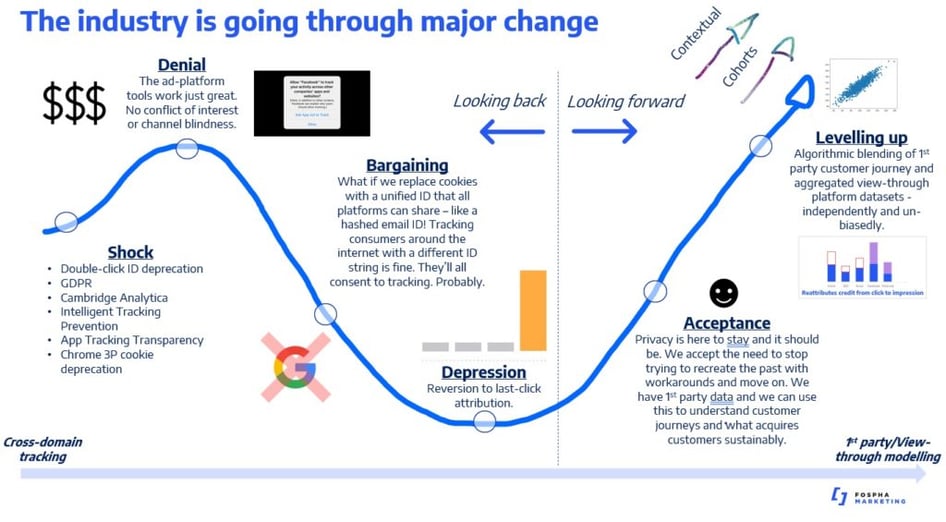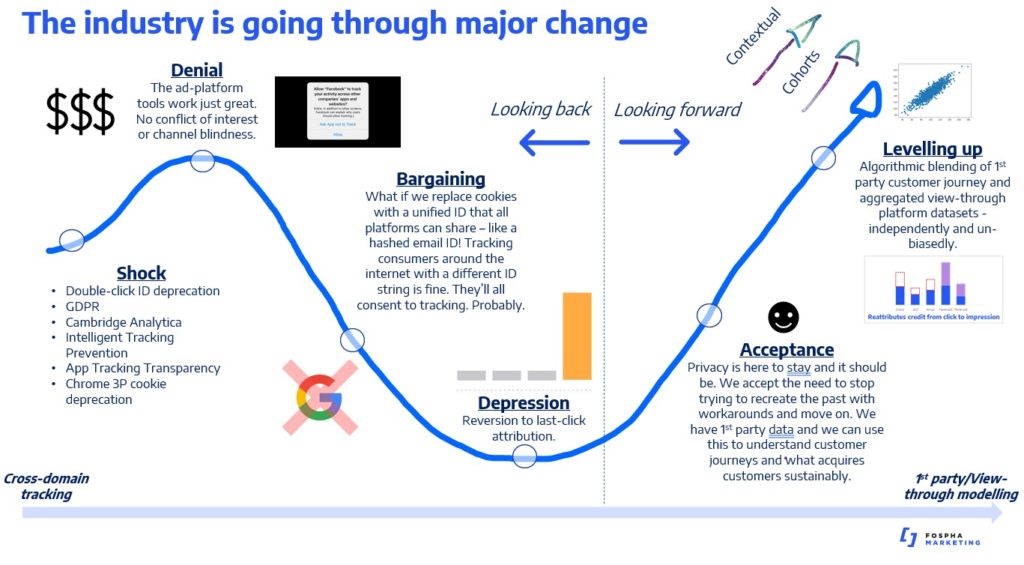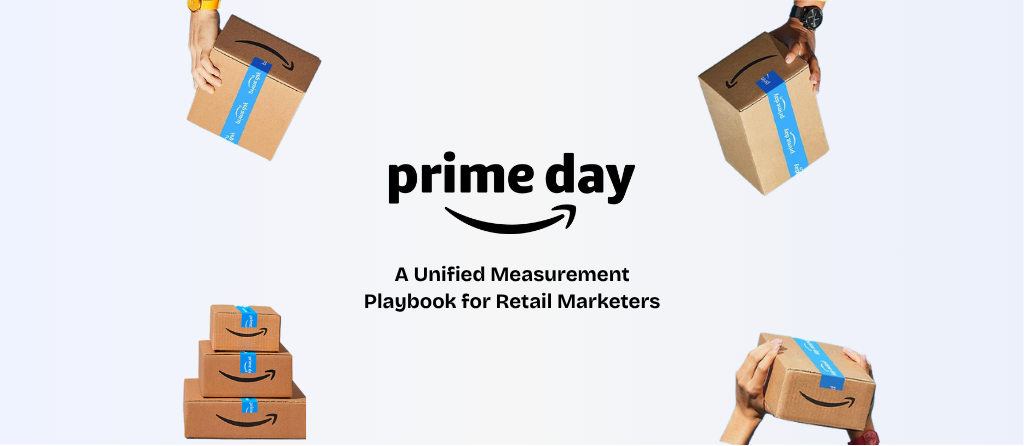Are you in denial? The Marketing data change curve.
The magnitude of recent change in data availability for targeting advertising and measuring marketing campaigns has seismic.
At Fospha we’ve been closely monitoring the market for changes in marketing data. Watching the different responses from brands and vendors has been telling, as we’re in a transitional phase, and those who adapt best will thrive. The science of adaptation to change has been studied by psychologists for decades, and the best known model for conceptualizing this is Elisabeth Kubler-Ross’ Change Curve, explaining the stages of human reaction to fundamental change: from shock and denial to acceptance.
Elisabeth’s model can help us understand much of what is happening today as our industry evolves towards a new settlement on appropriate and fair use of consumer data in advertising.
Shock
There’s no doubt that the past few years have seen incredible disruption in the world of marketing data and digital advertising. A series of systemic shocks have upended the approaches used to target, measure and attribute advertising, with intertwined and mutually reinforcing impacts from regulatory and technology changes. With regard to marketing attribution, the technologies and IDs – Doubleclick IDs and 3P cookies – the industry largely relied on have been deprecated over the last few years. Paired with the rising consumer consciousness around digital privacy and consequent distrust of the mega-platforms, walled gardens have gone up around the internet, exploding the already dubious promise of 360 degree attribution across the customer acquisition journey. This period has left the industry transitioning through the marketing data change curve trying to adapt to the new reality.
Denial
Most Marketers have historically relied on ad-platform owned tools to measure the performance of their marketing data; they are free and easy to access. But there are some important truths that can’t be denied about their ability to give an accurate view on cross-channel marketing attribution. For example, they’re measuring the performance of their own media; and apart from obvious questions of conflict of interest and lack of incentive to tell you to stop spending money on their platform campaigns past the point of inefficiency, they’re naturally going to over-index on attribution of credit to marketing touchpoints they can see and deterministically prove – interactions with their own media instances and properties – so of course they will get more credit… they couldn’t possibly do otherwise. Much of the industry understands that using the platform tools should be used as context and not as a sole tool for attribution and optimization.
But many are still in denial. There is a lot of inertia in the industry on this point, especially within less innovative agencies who are used to a certain way of doing things with platform tools, despite the increasing understanding of their limitations. All brands should be asking themselves if their interests are truly aligned with those of their agency & platform partners when it comes to making channel spend allocation decisions, incentivize based on measurable goals aligned with their brand’s strategy and properly interrogate resistance to change.

Bargaining
In the world of Marketing Data, Unified ID is a hot topic, with various initiatives in play and backing from the IAB amongst other industry bodies. The goal is to establish a shared ID for the independent web that can be used to target and measure in a post-cookie world. However, Unified ID is somewhat analogous to the bargaining phase of curve – we can’t use this persistent identifier anymore (third-party cookie) so can we use this one (Hashed email)? In technical implementation, both are string IDs which are used to track customer activity and ad exposure across third party domains. The obvious response to this from those backing the initiatives would be ‘But we have consent… They’ve opted in.’ and though this may be correct on one level, it begins to feel like a technicality which is at odds with the sea-change of consumer attitude towards Marketing Data privacy – did they really know what they opted in to? Did they understand they were opting in to have their data shared across your whole network? Were you explicit that it would mean you would use their email address to track what they do on other websites? Is each consumer knowledgeable enough to understand the implications? – this is in stark contrast to a first-party relationship that a consumer builds with a brand where they are agreeing to share their data with that brand because they have an interest in the brand or are a customer of the brand already.
For those reasons I have reservations regarding the ability to scale these audiences without running into increasing scrutiny from regulatory authorities and that will become a minefield. Though I fully support the idea of what independent AdTech is trying to do in creating alternatives to BigAd! It might end up being an Icarus-like solution in that the closer it gets to its goal the more implausible it is that it is consumer-safe; in their mass-scale success scenario the plausibility that the whole audience is opted-in with conscious consent to be tracked across the web falters. And so the approach feels like bargaining to re-create facets of the past rather than really innovatively visioning the future.
Additionally, with the big ad platforms remaining walled gardens – and Google explicitly rejecting the adoption of unified identifiers throughout their stack – the solution cannot fully solve for the problem of ID fragmentation, with any competing unified ID networks further balkanizing the web. Given this, I can see the utility in targeting ads at the ‘unified’ audience of a decent scale… rather than for measurement and attribution, at least in a cross-channel context.
Depression
From a marketing data measurement perspective, it’d be understandable to get depressed and turn to drink or last-click attribution modelling. And for those using Facebook Attribution there has clearly been a lot of disruption recently with iOS14/ATT, with impacts to data availability and therefore look-back windows. Good questions arise – how can we make sure we are spending marketing budget well in a post-3P cookie world? are we going back to flawed models of the early part of the century? – and the answer should be no, we’re not returning to those basic heuristics and yes we can still use technology and science to spend our money better, we just need to think differently about how we achieve our goals (see Levelling up).
Acceptance
The world is very different than it was just a few years ago, with incredible acceleration of existing trends over the course of the pandemic. It is not going back to the way it was, though aspects of our former world will be retained. The question is, will consumer attitudes regarding the collection and processing of their data go into reverse? We think this is unlikely and not desirable. Can they be persuaded to give away data for gain? Possibly, but in the here and now the conversation begins to manifest the spirit of Berthold Brecht’s famous line –Would it not in that case be simpler for the government to dissolve the people… and elect another? – no, privacy shouldn’t be up for debate, nor should we be trying to find regressive workarounds. It is incumbent upon our industry to re-think our approach to consumer data and privacy. We should accept that and move on to create new solutions and technologies fit for today’s world, not facsimiles of the past. Accept there is some data you can use to target & measure advertising – and there is some you cannot and should not.
Levelling Up
There is so much great innovation going on across the industry, with forward-looking vendors and agencies solving for these problems with privacy built into the heart of the solution. This is not only good for consumers, it is good for business and it is good for brands.
Why? Vendors and brands can address their biggest problems without risking having the rug pulled from under the feet by regulators or BigAd, safe in the knowledge they’re not working in a grey-area of dubious data provenance. That has happened a lot in the past few years, and it is a huge enterprise and reputational risk. Why tolerate it?
It’s not new news, but you absolutely have to focus on 1st party marketing data, and make sure you drain as much value from that asset as possible and use it for attribution, really understanding your customer and their journey. If you are not doing this, you need to start right now because you’re at a competitive disadvantage. Then, be conscious and smart about the other datasets that are available to you which can help you measure the effectiveness of your advertising. We can still use troves of third-party media data – in aggregate – which can be melded with your first party data to measure and attribute to marketing activity across channels and devices to drive great decisions. The great thing about huge disruptive change is it creates opportunities to think differently about how to solve the same problem, exploding the inertia of imperfect and corrupted incumbent methodologies. We read the runes at Fospha a few years ago and so we have been totally future-focused in building out technology to address today’s challenges, mixing appropriate modelling techniques across 1st and 3rd party marketing data to deliver the most effective solution for growth and cross-channel attribution available to brands today.
We see other great UK vendors we know who are building analogous solutions for the targeting space whether that is in contextual or differential privacy and are excited that we are part of a wave of forward-looking AdTech/MarTech which is at peace with the emergent data settlement of the 2020s and helping their clients not only survive but make the most of the material opportunities present with the massive growth in eCommerce and competition in digital that it will drive. Levelling up our industry’s practice & reputation, whilst delivering great value for our clients – the brands – and safety and peace of mind for their customers. That is a curve we like the shape of.


